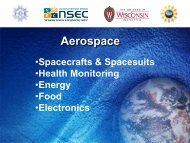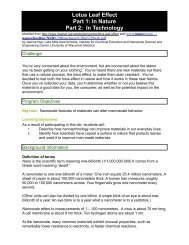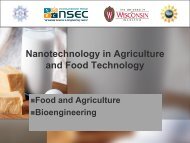Environment and Nanotechnology - Institute for Chemical Education
Environment and Nanotechnology - Institute for Chemical Education
Environment and Nanotechnology - Institute for Chemical Education
You also want an ePaper? Increase the reach of your titles
YUMPU automatically turns print PDFs into web optimized ePapers that Google loves.
Nanomanufacturing problems<br />
Researchers at the University of Illinois at<br />
Chicago (ref. 1) have found that some<br />
nanomanufacturing processes are expensive<br />
<strong>and</strong> not very environmentally friendly:<br />
• Strict purity needed <strong>for</strong> starting materials<br />
• Repetitive processing steps<br />
• Processing requires extreme environments<br />
– High temperatures<br />
– Cryogenics (extremely cold)<br />
– Cleanrooms<br />
• Use of toxic chemicals <strong>and</strong> solvents<br />
• Generation of greenhouse gases<br />
• High usage of energy <strong>and</strong> water<br />
• Low yield compared to starting materials<br />
NASA’s Microsystems Fabrication<br />
Laboratory Cleanroom. Photo<br />
credit: Marvin Smith/ NASA<br />
As a result, the EPA is pushing<br />
<strong>for</strong> research in improved<br />
nanomanufacturing<br />
processes that are more<br />
environmentally benign. [2]<br />
Resources [1] Sengul, H., T. L. Theis, <strong>and</strong> S. Ghosh. "Toward Sustainable Nanoproducts: An Overview of Nanomanufacturing Methods."<br />
Journal of Industrial Ecology 12.3 (2008): 329-59.<br />
http://www.uic.edu/depts/ovcr/iesp/Publications/Faculty%20Publications/Theis/Theis_Toward%20Sustainable%20Nanoproducts<br />
.pdf<br />
[2] Savage, N., “Research Advancing Green Manufacturing of <strong>Nanotechnology</strong> Products,” EPA,<br />
http://www.epa.gov/nanoscience/quickfinder/green.htm













